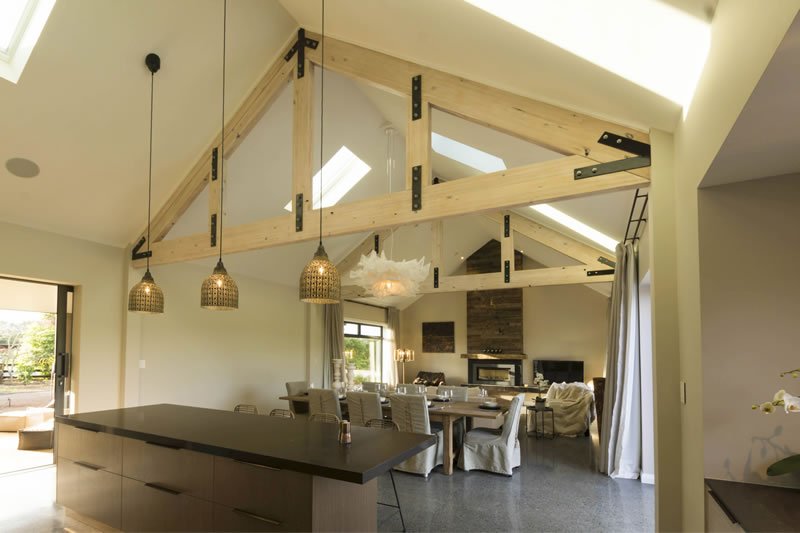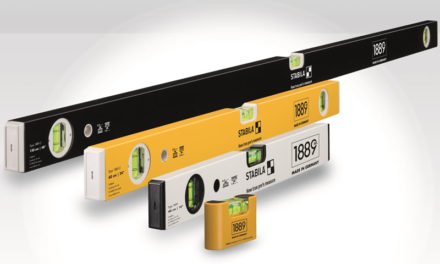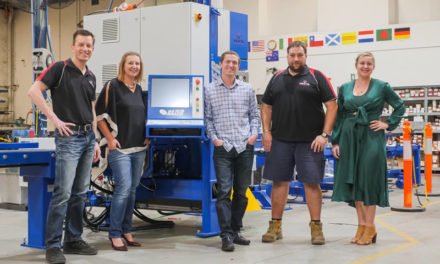We talked with leading Australian manufacturers of GLT and LVL about how the past year’s import shortages have affected them and what’s ahead this year and next.
Michael Lee, operations manager at CUSP, isn’t one for beating around the bush. “The reality is,” he says, “if LVL was available in sufficient quantity, we wouldn’t be having this conversation. We wouldn’t have had a lot of the conversations we’ve had this year with people across Australia.”
With only one Australian supplier of LVL and lead times on imports blowing out to months. CUSP has been one of the Australian glulam (GLT) manufacturers who have benefited from the subsequent high demand for timber products that can substitute. But it’s not a simple story. We spoke with the teams at CUSP and Hyne, as well as Wesbeam, Australia’s only local LVL manufacturer, for an overview of what’s been happening here. In future issues, we’ll also look at local CLT manufacture and the increasing number of quality Australian producers in the market, including Timberlink’s new GLT and CLT plant
In-demand LVL
On the one hand, this is a good news story: Australian builders love LVL and are fairly enamoured of EWP in general. Engineered timbers have become integral parts of many builds, and when global supply chains fell apart in 2021 and the stream of imported EWP – especially LVL –was interrupted, there were a lot of panicked phone calls.
Some of the gap was made up from stockpiles, which have gone from months’ worth to practically nothing, some came from Wesbeam, Australia’s sole LVL and I-joist producer. “Being the only Australian manufacturer of LVL and I-joist, Wesbeam has been insulated from the massive disruption to international supply channels, further increasing demand for our products,“ says Denis Cullity, marketing director at Wesbeam.
The company is well placed: it manages its own processes from tree (with log supply secured by WA State Government legislation) to trade, including fully integrated design and technical support teams Australia wide – which have been vital parts of educating the local market on EWP use in recent years. But even it hasn’t been in a position to fill all the gaps arising from the drop in supply.
“With increased housing starts, demand for LVL products in Australia has increased while supply lines for LVL imports have been challenged,” Cullity says. “Wesbeam’s focus is on its longstanding and loyal customer base, who have a stated preference for Australian-manufactured products.”
As a result, Wesbeam has pulled back on some of their previous engagement with various construction sectors. “In addition to the residential construction market, Wesbeam maintains close product and service relationships with a select number of prefabricated building manufacturers,” says Cullity. “As an Australian company, we’ve been able to rapidly respond to changes in the market. Rationalisation of our product offer has enabled us to focus on the products required for residential construction.”
The company is well known for close relationships with its customers, which it maintains through its sales team, EDMs and the comprehensive Wesbeam website. Cullity says that the customer base, who have long expressed a preference for Australian-manufactured products have even more reasons to appreciate the relationship now. Looking at the drivers of international supply chain disruptions and the impact of a strong US housing market, he doesn’t expect a quick resolution to the issues.
“The US is the largest consumer of LVL products,” says Cullity. “They’ve been under-building for the past 10 years and will need to construct houses at near record levels for another four to six years just to meet the underlying demand for housing.
“European and American manufactures of LVL also prefer the higher prices and shorter shipping times they enjoy in the US market compared to Asia-Pacific markets.”
Glulam steps in
The limited supply of LVL has been partially balanced by an increased use of glulam, or GLT as the manufacturers prefer to call it.
Established and new GLT suppliers were already expanding their offer to the market before the 2021 boom in demand. Hyne Timber’s highly anticipated Maryborough GLT plant has recently come online and the company is starting 2022 with a soft launch to existing customers of a new GLT product, with a full rollout planned for April.
“We were in the same place as many other major timber companies in 2021,” says Stefan Gerber, engineering and sales manager GLT at Hyne Timber.
“We weren’t able to take on all the new customers who were reaching out to us and we had the same fibre supply issues that affected much of the domestic market. Increasing production capacity with our new manufacturing plant was our original response, to supply more glulam to the market, but we ran into issues. Basically, the changing nature of our log resources. The high-grade feedstock we recover from our sawmillling operations has been steadily declining for the past 18 months or more.”
Hyne’s best-selling GL17 product, Beam 17, required very high-grade feedstock and there simply wasn’t enough for the quantity the market was demanding. Waiting for new feedstock to grow wasn’t an option, nor was continuing to supply a high-grade product at low volumes, especially when the vast majority of applications the beam was being used in did not require the full suite of engineering characteristics of GL17.
So, over 2020-21, the Hyne team developed Beam 15, a new grade of product.
“It meant we could increase availability, which is obviously important in a market with very high demand,” says Gerber. “It’s still a high-performing product at a slightly lower MOE, that’s the stiffness which governs most designs. The same sized beams can be used in many applications, yet we have much more feedstock fibre available to us.”
Beam 15 has successfully passed a raft of testing, first in-house at Hyne’s 500m2 R&D facility and then through the third-party accredited testing program run by EWPAA with the assistance of Griffith University. A full product technical statement is available and Beam 15 is already loaded into Hyne’s updated design software, ready to deliver engineering solutions to customers.
“The good news is Beam 15 performs very, very closely to a GL17,” Gerber says, “so in a high percentage of cases, it will do the same job. We received a lot of feedback on this from our customers from the design community. The difference is so minimal, yet it makes a huge difference in the availability of the timber we can use.”
Hyne custom grades its glulam laminates at the company’s own sawmills, which helps to deliver performance at the top of the grade. “To achieve a GL17 grade, we’ve always custom graded our laminate at a much higher percentage than the highest available in the market,” says Gerber “And we’re doing the same thing with Beam15.”
Coming to market in the same sizes and stock range as Beam 17, but with more supply, Beam 15 should prove a boon to builders crying out for product, without adding difficulty for specifiers or engineers.
Tweaking plans
When Tasmanian-based market newcomer CUSP was originally looking at its first year of operation across 2021-22, the company expected to be focused on CLT. “GLT was always on our horizon,” Lee says. “It was just not intended to be at the forefront while we got the CLT underway. However, it very quickly came through!”
Launching both products in mid 2021, CUSP quickly pivoted to a far larger share of GLT than projected. Happily, the machinery and processes had been planned to allow the company to meet orders as they came in, with rotary presses and other plant that were designed for either edge lamination or face lamination. “We’ve got a very large fingerjointer, which allows us to be cost competitive in length,” says Lee “We can fingerjoint up to 14m and our rotary presses are at 7.2m and we have some capability for even longer stuff through a manual process.”
Opening with one shift, CUSP will be expanding its staff profile shortly. Much of the work is still in increased orders for GLT, many from residential builders who would usually work with LVL.
“GLT is usually specified intentionally, with designers wanting to highlight one or more of its qualities, whether that’s looks, length or strength,” Lee says. “We’re seeing more of that now, but for the first six months, a lot of our CNC capability was running replacement for LVL. Because the structural properties of their traditional LVL product are known, most builders could easily transfer to GLT.
“The fact there is a Standard for GLT makes it easier for architects, because they can just specify a grade rather than a branded product. One issue is that the Australian Standard for light timber framing doesn’t have the GL grades incorporated, so that sometimes creates a little bit of confusion. They’re not sure if they can use GL grades to replace those F or LVL grades, because the span tables are not in the Standard. But if there is an engineer in the project, they can easily substitute.”
Coming from north-west Tasmania, CUSP has an even stronger environmental story to tell than most EWP producers. Using FSC- and PEFC-certified Tasmanian Plantation Oak (Eucalyptus nitens) and Grandis Plantation Oak imported from Uruguay as sawn product (“We had sufficient quantities already in stock and have only been importing top-up material, so a couple of weeks’ delay hasn’t affected us,” Lee says,) the focus is on the local timber supply, which will be the sole feedstock in the future.
“That’s a story that ties in very succinctly with the big pile of wood chips on the Burnie Wharf and turning that into GLT for the built environment,” says Lee. “It’s revolutionising how we see E. nitens as a product. And with that comes employment and the carbon story is beautiful, too. There’s no negatives to engineered wood products in Tasmania, that’s for sure.”
In addition to being the main fibre source for CUSP’s GLT and CLT, the company has spearheaded an appreciation of the nitens’ value as a fibre source, helping local traditional timber companies bring on solid board products in E. nitens. For its EWP, CUSP is able to use trees aged just 16-25.
“There’s a hell of a difference in the business model layer,” Lee says. “We are radically challenging the drying times from green to dry boards for a mass timber product, which comes with a whole heap of factors that you wouldn’t necessarily want in solid board production, but which are quite acceptable in engineered wood products.”
Most GLT is currently going out as GL13 with a mixed lamella set-up. “It lets us get the best use out of the fibre supply, which is important,” says Lee. “And it’s really well accepted into the market. As a CLT producer, we use early engagement on our CLT products because they’re about delivering a project, not a retail product. We’re doing that with GLT, too. We’re diving into some early engagement with larger projects with post and beams and so on, making sure the material that’s actually proffered forward is the most sensible material, and not necessarily one that’s come straight off a span table.”
In the long run
Things will eventually sort themselves out to either the old normal or some new status quo, but there are already lasting impacts that can be seen coming from this period.
The first is more appreciation for local supply. Even if it hasn’t been able to fill 100% of the imports gap, it’s kept Australia building through 2021, and there is a renewed appreciation for the importance of local manufacture and its flow-on benefits.
“Wesbeam customers have voiced their appreciation for the reliability of our delivery schedules and the quality of the design and sales service we bundle with our product offer,” says Cullity.
The transparency of local certification processes and their testing and certifying bodies has been an additional bonus to builders – and to their customers and insurers, particularly in a market made nervous by front-page building failures.
The second is more appreciation for GLT in its own right. While it’s long been a part of the available product mix, it’s not been thought of as intensively as the previously ubiquitous LVL or as CLT, which requires careful planning before ordering.
After 2021, a lot more builders are aware of the product’s structural qualities, but also its ability to take starring roles in designs. “While the great bulk of our GLT goes out in Appearance Grade B, where it’s never going to be seen,” says Gerber, “our appearance Grade A is very nicely finished and has been often used in mass timber buildings where it’s completely visually exposed. So it’s a structural element of a building, but at the same time a hero visual feature.
“We also have a hardwood beam, Beam 21, which is the strongest glulam beam I know of in the world. And it’s visually beautiful for exposed applications. We’re seeing more specifications into mass timber buildings that really celebrate the appearance of GLT.”
Lee agrees, “We aim to put out product that is always visually acceptable, and that’s definitely appreciated. Where we’ve found a big change is in pricing expectations.”
In the first push of people trying to supplement a lack of LVL with GLT, he describes CUSP as being “stuck with pricings –or people’s expectations of pricings – around LVL, not GLT. That perception is changing and the price of GLT is becoming more acceptable.”
There’s reason to hope the broader market is coming to understand that pricing for engineered wood products is a whole package, not just a commodity subject to market vagaries. This is something the CLT market has managed to emphasise, with its focus on delivering specific panels for specific projects, but which had been rather lost for LVL, where many buyers previously expected to be able to drive prices down, and had become mistier around GLT.
“Unlike CLT, where there’s a whole lead to manufacturing process for building, we can supply GLT as a commodity against LVL. But there is a value integral to all engineered product that shouldn’t be pushed down when the market is less tight,” says Lee.
Hyne sees things similarly. “We’ve been speaking with builders and obviously we’ve had a range of reactions,” says Gerber, “but whenever we explain why the price has gone up, they generally understand that prices haven’t followed the Consumer Price Index – that’s all structural timber, including engineered wood. Meanwhile the costs of doing business have increased significantly, so a correction was overdue.”
More pricing certainty will help drive investment in local EWP production, whether that’s further expansion for established manufacturers (and there are many quality Australian GLT producers not in this story) or with new participants like Timberlink.
One thing everyone agreed on is that they will be happy to see the end of some parts of 2021. “It’s stretched everyone,” says Gerber. “With the launch plan for Beam 15, we’re in a good place, but it’s taken time. We can’t jump up the volumes and manufacturing capacity from one day to the next. We’ve had to build the new GLT manufacturing facility, a brand new warehouse at the Port of Brisbane to service southeast Queensland in a timely manner and tweak our NSW supply out of Newcastle and our Victorian distributors.”
Managing all this through Covid hasn’t been easy, Gerber says: “Covid procedures had to be followed when visiting our own manufacturing sites to ensure we have zero cases at these sites; one case could cause a plant to shut down for a period and that would have been a disaster for us and our customers. Getting external technical experts in from other countries has been even more difficult. A lot has to be done over Teams and phone.
“The supplier of the manufacturing equipment is from Taiwan. We had specialists in once everything was installed to help us out on the programming side and automation side and they had to quarantine on the way in and back!”
The CUSP team is looking forward to being able to return their output to more of a balance between GLT and CLT. “We have a lot more large-project CLT job quotes at the moment than we expected – probably 20% above where we thought we’d be in enquries, if not slightly higher,” says Lee.
“As we expand our staff profile, that’s going to help us with our capacity to meet orders. People are really understanding the sustainability story that our products represent, as well as their engineered qualities, and carbon is becoming a very high priority, particularly on a lot of architects’ agendas.”
Overall, it might be this increased closeness and communication between suppliers and customers that leads to the most lasting change. “Thinking and solving problems is the work of leaders,” Cullity says. “Wesbeam is fortunate to have intelligent, industrious and creative thought leaders across our business. Just like a good sportsperson we’re always asking ourselves: ‘what’s going to happen next?’
“We’ve been asking ourselves this question before Covid became a part of our lives and we will continue to ask it long after. Our customers expect Wesbeam to use its privileged position as an Australian manufacturer to look to the future and innovate in ways that benefit Australian residential construction.”
For more, visit www.cusp.com.au, www.hyne.com.au and www.wesbeam.com
Image: Hyne GLT beams are available in visual grades for exposed architectural use.












